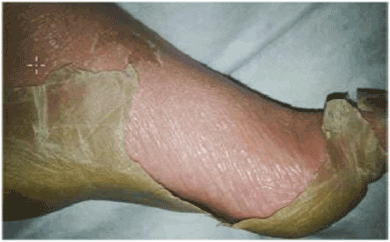Contents
Lyell Syndrome
What is it ?
Lyell syndrome is an acute, rare and serious condition most often caused by a drug allergy. It is characterized by the destruction and sudden detachment of the surface layer of the skin (epidermis) and mucous membranes (epithelium) over a large part of the body. The designation toxic epidermal necrolysis (NET) intersects with Lyell syndrome and Stevens-Johnson syndrome (SJS), which correspond to different degrees of the same pathology: we speak of Lyell syndrome when the necrolysis extends over more of 30% of body surface area and Stevens-Johnson syndrome (SJS) when it is less than 10%. Note that scientists tend to adopt a single terminology: SJSTEN or epidermal necrolysis. The disease is extremely rare: its incidence worldwide is 1 to 2 cases per million inhabitants per year. In France, around 120 cases are recorded each year. (1)
Symptoms
The cutaneous involvement occurs suddenly 5 to 10 days after taking the attributable drug. The neologism “necrolysis” combining “necrosis” and “detachment” is explicit: the epidermis necroses over its entire thickness, then detaches from the dermis. The first symptoms are a fever and a rash on the face and the upper part of the trunk, which directs the diagnosis on the trail of chickenpox, before the epidermis peels off in the form of vesicles (bullous dermatosis or Nikolski sign). At the slightest friction, it comes off and leaves the dermis raw and oozing. The mucous membranes of the mouth, eyes, genitals and anus are also affected in the vast majority of cases. In the most severe cases, lesions can also affect organs in the respiratory tract and digestive tract.
The origins of the disease
Lyell syndrome is most often caused by an allergy to a drug, more rarely an infection or a bone marrow transplant. It should be noted that its cause remains undetermined or uncertain in a quarter to a third of cases. The number of drugs involved is large, but only ten of them are responsible for the majority of cases of epidermal necrolysis: allopurinol, anti-infectious sulfonamides, nevirapine, carbamazepine, lamotrigine, phenobarbital , phenytoin, non-steroidal anti-inflammatory drugs derived from oxicam. (1) Genetic, immunological and viral factors could also come into play. Lyell syndrome is most often caused by an allergy to a drug, more rarely an infection or a bone marrow transplant. It should be noted that its cause remains undetermined or uncertain in a quarter to a third of cases. The number of drugs involved is large, but only ten of them are responsible for the majority of cases of epidermal necrolysis: allopurinol, anti-infectious sulfonamides, nevirapine, carbamazepine, lamotrigine, phenobarbital , phenytoin, non-steroidal anti-inflammatory drugs derived from oxicam. (1) Genetic, immunological and viral factors could also come into play.
Risk factors
Women are slightly more at risk of toxic epidermal necrolysis, and people with AIDS are 10 to 100 times more likely than the rest of the population.
Prevention and treatment
When epidermal necrolysis is suspected, hospitalization as quickly as possible is necessary, in an intensive care unit for severe burns. Because the clinical picture, the complications and the risks are identical to those linked to extensive second-degree burns: renal failure, heart problems, infections … They are life-threatening while the epidermis regenerates, from 15 to 21 days. Treatment is based on identifying and stopping the offending drug, rigorous asepsis, intravenous rehydration, and treatment of infections with antibiotics.
The affected person may be in an induced coma when the pain becomes too intolerable. Thanks to improved resuscitation care, the lethality of the disease has decreased and now stands at around 20%. (2)











соня сайванска как трябва да се лекуваме сега при тия вирусни инфекции можели да.пия анти вирусни средства или какво друга да косомирамза.лечение отвирус